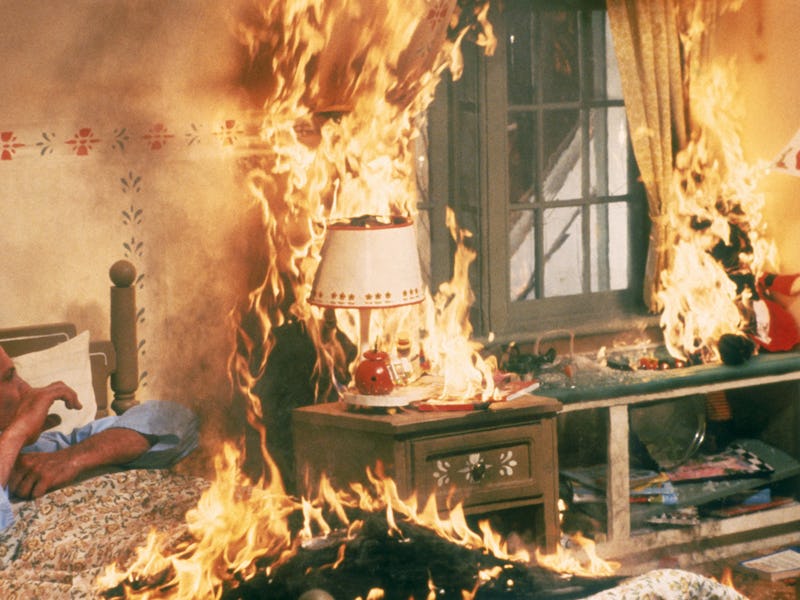An Obscure Stephen King Adaptation Is Also the Perfect Template For the Author’s Work
Cronenberg stayed faithful to King’s story but trimmed the fat, a model other directors should follow.

For as long as Stephen King has been writing books, people have been adapting his work. Thanks to a distinctly cinematic writing style, stories that have obvious commercial appeal, and his own popularity, King has been good for the movie business to almost the same extent he’s been good for the book business.
These many adaptations have had a wide variety of receptions. Some, like Stanley Kubrick’s The Shining, use the material they’re based on as a springboard for their own ideas and turn out great. Others, like every adaptation of Firestarter, adapt King faithfully, but without any of the artistry the author brought to the page.
The Dead Zone, David Cronenberg’s 1983 adaptation, feels close to ideal. It’s a faithful adaptation, but more importantly, it captures what it feels like to read King’s book. The story has immediate genre appeal: a man falls into a coma, and after recovering he discovers he has powers of precognition, which he uses to do good at a heavy personal cost.
The movie hues pretty closely to the novel, although it trims additional plot threads. But the core story, of a man who meets a potential authoritarian and wrestles with whether to assassinate him, remains the same. Cronenberg’s adaptive choices, which include a chilly, muted color palette and the casting of Christopher Walken and Martin Sheen to play the central roles, only reinforce the terrifying ideas at the center of King’s book.
To the credit of both Cronenberg and his actors, those central performances are what make the movie so captivating. As Johnny, Walken is a man haunted by his gift. His knowledge of the future leads to only misery and internal conflict, and Walken’s performance is perfect as a man slowly unraveling. Sheen’s Greg Stillson, meanwhile, seems to be coming undone in an entirely different way. A populist who finds his political stature growing, Johnny sees a vision and understands that Stillson is destined to become an unhinged president willing to unleash America’s nuclear arsenal on his enemies. Sheen is just as captivating as Walken, toeing the line beautifully between a craven, captivating politician and an unhinged madman.
It’s that feeling of doom that, somewhat counterintuitively, makes The Dead Zone so gripping. The only happy ending comes from averting an even worse ending. Twenty years before the superhero boom, The Dead Zone feels like a movie about a superhero who understands how awful it would be to have powers. It also feels even more relevant decades after its release, as we see the rise of figures like Stillson in the real world.
One of Walken’s best roles, and one of his best outfits.
Cronenberg’s obsessions with body horror and the limits of what a human can endure are all present in The Dead Zone, but they’re sublimated into the text of King’s original story. Cronenberg chose to tell King’s story pretty straight, allowing for some stylistic flourishes in how he presents Johnny’s visions, but otherwise keeping things minimalist. Instead, the director finds himself fascinated with the slow deterioration of Johnny’s mind, understanding that the horrors of this movie are firmly psychological.
The despair and hurt so central to this movie (and to King’s oeuvre) is almost perfectly captured in one late scene. It’s the movie’s most memed moment, but it still plays powerfully in context. When Johnny discovers that one of the students he’s tutoring is going to fall through the ice and drown while playing hockey, he does everything he can to convince the boy’s father to stop his son. He’s the only one who can avert a terrible fate, and he has to resort to any means necessary. After smashing a vase and knocking over a table, Walken screams, “THE ICE! IS GONNA BREAK!”
It’s a moment of total clarity for Johnny and the viewer. Being the hero is a curse. When Johnny is shot after trying to assassinate Stillson, he gets the confirmation he needs that the future has been saved. Finally, as he breathes his last, he allows himself to smile. In these final moments, he’s prevented the worst from happening. His work is done.
This article was originally published on